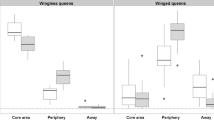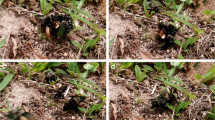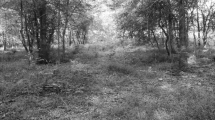Summary
Ergatoid males of the ant,Cardiocondyla nuda, attack and frequently kill young males during or shortly after eclosion. Smaller colonies therefore contain typically only one adult male, which may inseminate all alate queens which are reared in the colony over a few weeks. In larger colonies, several males may be present, however, fighting among adult males was not observed. We discuss the significance of male fighting behavior in ants.
Similar content being viewed by others
References
Buschinger, A., 1974. Experimente und Beobachtungen zur Gründung und Entwicklung neuer Sozietäten der sklavenhaltenden AmeiseHarpagoxenus sublaevis (Nylander).Ins. Soc. 21:381–406.
Davey, K. G., 1985. The male reproductive tract. In:Comprehensive insect physiology, biochemistry and pharmacology (G. A. Kerkut and L. I. Gilbert, Eds.), Vol. I. Pergamon Press, Oxford, pp. 1–14.
Hamilton, W. D., 1979. Wingless and fighting males in fig wasps and other insects. In:Sexual selection and reproductive competition in insects (M. S. Blum and N. A. Blum, Eds.), Academic Press, New York, pp. 167–220.
Hölldobler, B., 1966. Futterverteilung durch Männchen im Ameisenstaat.Z. vergl. Physiol. 52:430–455.
Hölldobler, B. and S. H. Bartz, 1985. Sociobiology of reproduction in ants. In:Experimental behavioral ecology and sociobiology (B. Hölldobler and M. Lindauer, Eds.), G. Fischer Verlag, Stuttgart, pp. 237–257.
Hölldobler, B. and E. O. Wilson, 1990.The ants. Belknap Press of Harvard University Press, Cambridge, Mass. 732 pp.
Kinomura, K. and K. Yamauchi, 1987. Fighting and mating behaviors of dimorphic males in the antCardiocondyla wroughtoni.J. Ethol. 5:75–81.
Kugler, J., 1983. The males ofCardiocondyla Emery (Hymenoptera: Formicidae) with the description of the winged male ofCardiocondyla wroughtoni (Forel).Israel J. Ent. 17:1–21.
Kukuk, P. F. and M. Schwarz, 1988. Macrocephalic male bees as functional reproductives and probable guards.Pan-Pac. Entomol. 64:131–137.
Loiselle, R. and A. Francoeur, 1988. Régression du dimorphisme dans le genreFormicoxenus et polymorphisme comparé des sexes dans la famille des Formicidae (Hymenoptera).Naturaliste can. (Rev. Écol. Syst.)115:367–378.
Lupo, A. and J. Galil, 1985. Nesting habits ofCardiocondyla wroughtoni Forel (1890) (Hymenoptera: Formicidae).Israel J. Ent. 19:119–125.
Passera, L., 1984.L' organisation sociale des Fourmis. Editions Privat, Toulouse, 360 pp.
Santschi, F., 1907. Fourmis de Tunisie capturées en 1906.Rev. suisse Zool. 15:305–334.
Stuart, R. J., 1990. Experiments on colony foundation in the polygynous antCardiocondyla wroughtoni. In:Social insects and the environment (G. K. Veeresh, B. Mallik, and C. A. Viraktamath, Eds.), Oxford & IBH Publ. Co., New Delhi, p. 242.
Stuart, R. J., A. Francoeur and R. Loiselle, 1987. Lethal fighting among dimorphic males of the ant,Cardiocondyla wroughtoni.Naturwissenschaften 74:548–549.
De Wilde, J. and A. de Loof, 1973. Reproduction. In:The physiology of insecta (M. Rockstein, Ed.), 2nd Ed., Vol. 2. Academic Press, New York, pp. 12–95.
Wheeler, W. M., 1910.Ants: their structure, development and behavior. Columbia University Press, New York, 663 pp.
Winter, U. and A. Buschinger, 1986. Genetically mediated queen polymorphism and caste determination in the slave-making ant,Harpagoxenus sublaevis (Hymenoptera: Formicidae).Entomol. Gener. 11:125–137.
Yamauchi, K. and N. Kawase, 1992. Pheromonal manipulation of workers by a fighting male to kill his rival males in the antCardiocondyla wroughtoni.Naturwissenschaften 79:274–276.
Yamauchi, K. and K. Kinomura, in press. Lethal fighting and reproductive strategies of dimorphic males inCardiocondyla ants. In:Evolution of Insect Societies (T. Inoue and S. Yamane, Eds.), Hakuhinsha, Tokyo.
Author information
Authors and Affiliations
Rights and permissions
About this article
Cite this article
Heinze, J., Kühnholz, S., Schilder, K. et al. Behavior of ergatoid males in the ant,Cardiocondyla nuda . Ins. Soc 40, 273–282 (1993). https://doi.org/10.1007/BF01242363
Received:
Revised:
Accepted:
Issue Date:
DOI: https://doi.org/10.1007/BF01242363




